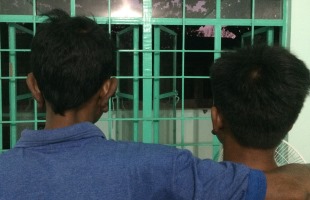 Brothers Edgard and Fernando, who are both in month 3 of their 12 months treatment for leprosy
Brothers Edgard and Fernando, who are both in month 3 of their 12 months treatment for leprosy
WHO/T.Hiatt
When we asked Edgar what he would tell another person who developed leprosy, he replied “It happened to me” and went on to explain that if he got through it, so can you. Edgar and his brother Fernando live in a rural area of the Philippines; they both are in month 3 of their 12 months treatment for leprosy. While the effects of the disease and the treatment can be challenging, the future looks bright for these two brothers planning to work as a mechanic and welder after completing their treatment. Their doctor has offered support beyond just curing the disease to get them priority spots for training in their desired professions.
Leprosy is a chronic disease caused by the bacillus Mycobacterium leprae. Leprosy is transmitted via droplets from the nose and mouth during close and frequent contact with untreated cases, but is not highly infectious. The disease multiplies very slowly with an incubation period of about 5 years. However, symptoms can take as long as 20 years to appear. If left untreated, leprosy causes progressive and permanent damage to the eyes, limbs, nerves, and skin.
The Philippines has the highest number of leprosy cases in the Western Pacific Region with 1665 cases recorded in 2014 (38% of the regional total). While the proportion of the population affected is low, leprosy persists in vulnerable populations that must be addressed. Due to the lack of awareness and the stigma that surrounds the disease, some people delay seeking help and are diagnosed too late to prevent life-changing disabilities. Leprosy is entirely curable through a course of multi-drug treatment.
"Today, the diagnosis and treatment of leprosy is simple and is available free of charge at the nearest health centre. With early detection and proper support, people affected with leprosy can lead normal lives" said Dr Mark Jacobs, WHO Acting Country Representative for the Philippines.
The World Health Organization works closely with the Philippine Department of Health and multiple partners such as the Philippine Dermatological Society, Research Institute of Tropical Medicine, Culion Foundation, Sorok Uni Foundation, Leonard Wood Memorial Laboratories, Cebu Skin Clinic, the Philippines Leprosy Mission, Korea International Cooperation Agency , and the Korea Centers for Diseases Prevention and Control to help sustain the quality of leprosy services and to ensure that all persons affected by leprosy, wherever they live, have an equal opportunity to be diagnosed and treated.
Developing leprosy is certainly a challenge, but it need not be a disaster. With the right support, people with leprosy can be found and cured all while living happy and productive lives.
